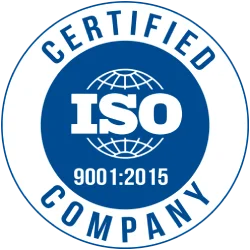Ultimate Guide to Commonly Used 3D Terms for Beginners
As a beginner 3D artist, you need to know what different terms mean to know what you are doing. Knowing the commonly used terms and what they mean can make your work go more smoothly.
Here’s a comprehensive glossary of the most common terms used in different 3D processes every beginner in 3D should know.

Processes
-
3D modeling
3D modeling is the process of constructing three-dimensional digital models of real, mythological, or even concept objects. These 3D models are created with the help of specialized computer graphics software called 3D modeling software. You get a grayscale model at the end of this process.
-
3D texturing
3D texturing is the process where we add details, patterns, color, and texture to a digital model. Applying textures to a model is often compared to putting skin on it. Textures go onto the surface of a model, usually without changing its geometry. They can be created from real photos or from scratch, with the help of mathematical algorithms, digital painting tools, etc.
-
3D rendering
3D rendering is the process of turning a 3D model or scene into a photorealistic 2D image. It follows the texturing process and is the last step of the 3D visualization process.
-
3D sculpting
3D sculpting is a method of making 3D models from a digital clay-like substance using push, pull, pinch, grab, smooth, and other actions. The process is very similar to the real-world task of making models out of clay. The artist uses sculpting tools like brushing and carving tools in the software to mold the digital clay. This technique is mostly used for making organic 3D models or models that have a lot of curves and irregular surfaces.
-
3D animation
3D animation (or digital animation) is the art of giving life to 3D models and environments through motion. In other words, it is the process of adding movement to digital objects like characters, environments, props, etc., to produce moving three-D images.
Terms used under different 3D processes
-
3D modeling
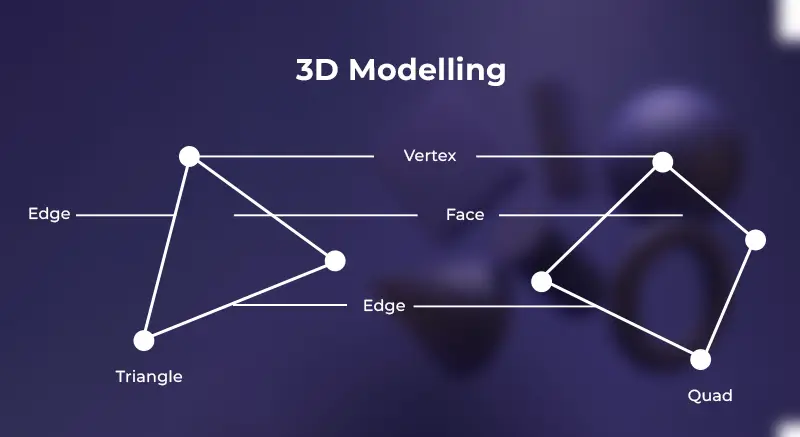
-
3D model
A 3D model is a digital representation of a real-world object made in three-dimensional space. They're a collection of points in 3D space that are connected in the form of lines, triangles, curved surfaces, and so on.
-
Vertices
A vertex is a point in 3D space that is part of a digital model's surface. The points can be on any axis - x, y, or z - and define the shape of the model.
-
Edges
Edges are straight lines that connect one point (or vertex) with another in 3D space.
-
Faces (polygon)
When three or more edges are connected together, the visible space between them is called a face. It's a basic geometric part of a 3D model. In the simplest of terms, polygons (or faces) are the building blocks of a three-dimensional model.
-
Mesh
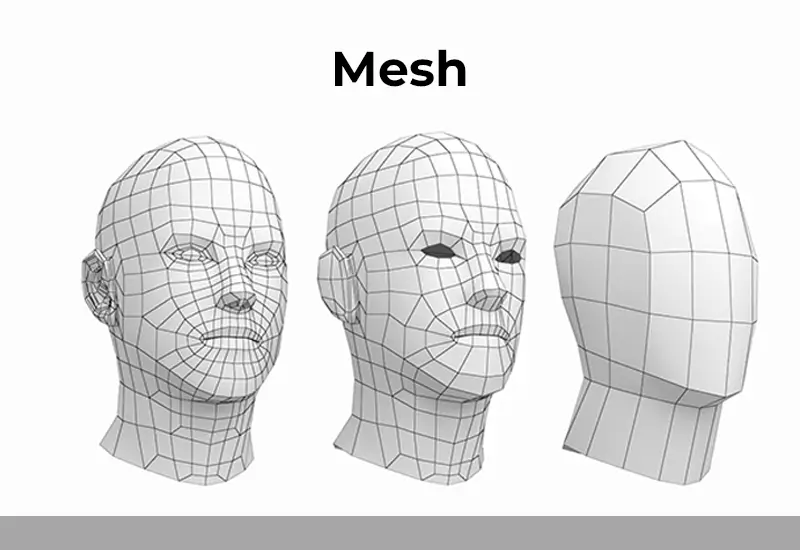
A mesh is made up of several polygons, edges, and vertices. It forms the structure of a 3D model and uses the x, y, and z, axes to define shapes in width, height, and depth.
-
Poly count
Poly count refers to the total number of polygons in a three-D model. If the poly count is high, it means the model is more complex and detailed.
-
High-poly and Low-poly
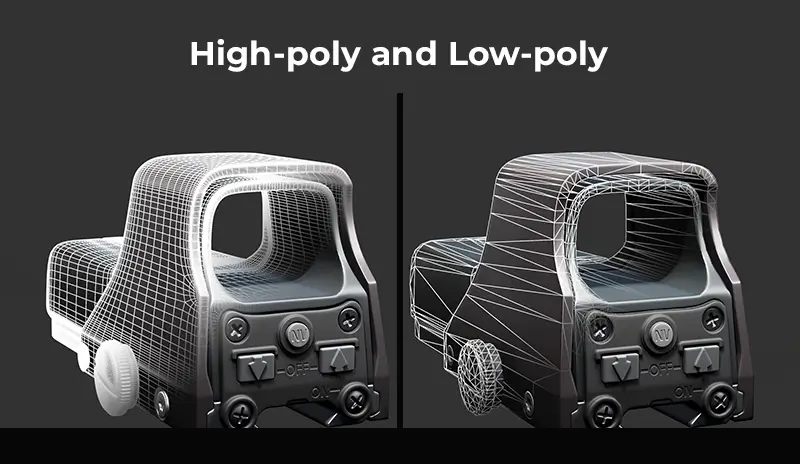
High-poly and low-poly refer to number of polygons in a model (or the poly count). Models with a high poly count are called high-poly models. When they have a lower poly count, they’re called low-poly models. High-poly is preferred for showing show close-up shots of the model’s intricate designs and surface details. Low-poly models are perfect for showing the overall product or object from a distance.
-
Geometry
When someone says “geometry” in the context of 3D models, they are talking about the mathematical and special properties of the model. The geometry of a digital model is made up of vertices, polygons (or faces), and so on, defining the shape and structure of the models.
3D texturing
-
Texture
A texture is a 2D image that is applied on a 3D model to give it surface detail. You can think of texture as skin that is put onto a 3D model. Textures give these digital objects color, patterns, details, and character. It is more of a general concept that refers to any digital model surface detail.
-
Texture map
A texture map is a type of texture that is applied onto a 3D object’s surface using coordinates. It makes up the details that get applied on a model. There are different types of texture maps, each of which gives the model a separate characteristic (color, pattern, bumps, etc.). Texture maps come as 2D image files like JPEG, TIFF, or PNG.
-
Material
A material is a set of settings that decide how a texture behaves when hit by light during rendering. Materials basically control the way a digital object looks under different lighting conditions.
-
Texture Mapping
Texture mapping is the wrapping or applying of 2D images (textures) onto a three-D digital object. Coordinates are used to fix points on the image to corresponding points on the model.
-
Texture Painting
Texture painting is a technique where a 3D artist applies colors, patterns, and details directly onto a 3D model. It's done with specialized software like Adobe Substance Painter and Blender. Layers, brushes, and other tools are used by an artist to paint on the models.
-
Roughness map
The roughness maps determine how much light is reflected by the texture. Depending on the characteristics you've given the roughness map, it can either make the part it is applied on rough or smooth.
-
Bump map
A bump map is a texture map that makes it look as though the digital object’s surface is bumpy or wrinkly. It merely gives the illusion of bumps by affecting the surface shading of the object.
-
Height map
A height map makes it appear as if some parts of a 3D model are elevated. It's a greyscale map that colors the surface in different shades of grey according to the height. Height maps are usually used to show large bumps and protrusions.
-
Normal map
A normal map is a texture map that lets you add details like bumps, grooves, and scratches to the surface of a model. It is an RGB map that alters the way light interacts with the model's surface.
-
Diffuse map
A diffuse map, otherwise known as a color map, gives the model a base color as well as some surface details (patterns, logos, etc.). This is a very important texture map and determines a lot of what the model will look like under various lighting conditions.
-
Displacement map
A displacement map gives height to parts of the model’s surface. It’s used as an alternative for the bump map as it actually changes the surface of the model. Other texture maps only impact how a model appears.
-
Texture baking
Texture baking is a process in which surface details, lighting information, and other visual effects are pre-computed and stored as texture maps. Once the textures are baked, they can be mapped onto a 3D object.
-
UV unwrapping
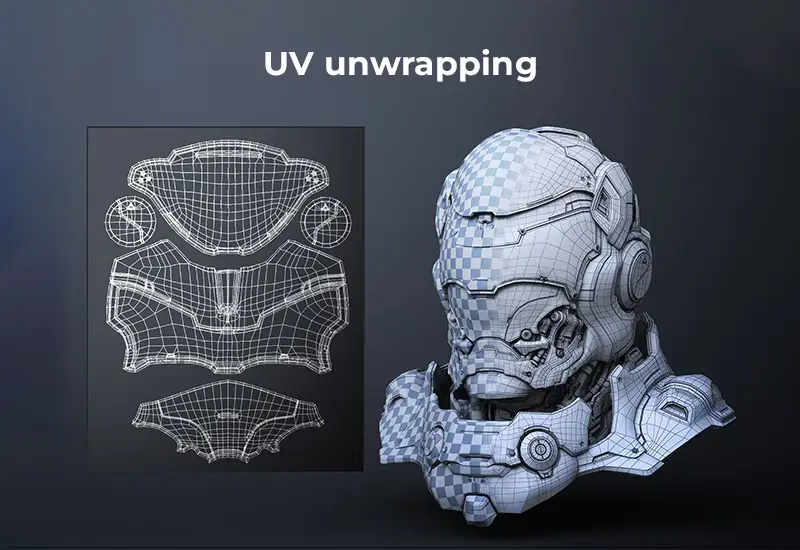
UV unwrapping refers to the process of opening up a 3D model and turning it into a 2D flat image. Artists use this technique so it is easier to texture the model's surface.
-
UV maps
A UV map is a flat (2D) representation of a 3D model. UV maps are made using the UV coordinates (known as texture coordinates) in a process called UV mapping. The U and V coordinates are on the horizontal and vertical axes, respectively.
-
PBR
Physically based rendering, PBR for short, is a shading and rendering technique that makes materials interact with light more accurately. That’s why it’s also known as physically based shading. PBR is used to make 3D models look more photorealistic.
3D rendering
-
Area Light
Area lights are a type of 3D lighting or a studio soft box style light. They work similar to lamps and produce soft shadows on the 3D model. They emit light evenly in all directions and are perfect for portrait lighting.
-
Point lights
Point lights are the 3D lighting version of real-world light bulbs. They are located at a point in three-D space and emit light evenly in all directions.
-
Directional lights
Directional lights function similarly to sunlight. They let out a wall of parallel light in the direction you aim it. Directional lights are particularly useful for lighting up scenes like the sun. For example, three-D scenes set outdoors. The direction of these lights can be changed using rotation. Changing the location of the source doesn't change the direction of light emission.
-
Spotlights
Spotlights are the three-D equivalent of real-world spotlights seen on stages. They light up a 3D scene like a spotlight would focus light on a character during a stage play. The lighting can also be compared to a flashlight.
-
Render Engine
A render engine, or rendering engine, is a software or plugin that turns a 3D model or scene into a viewable realistic 2D image or animation.
-
Render
The word render is often used to refer to the 2D image or animation produced as a result of 3D rendering. It’s also used to refer to the rendering process itself.
-
Real-Time rendering
Real-time rendering is, as the name suggests, rendering that is done in real-time. Here, the user gets to interact with the render as and when it is being developed.
3D animation
-
Rigging
Rigging is the process where you create a skeleton for a 3D model. This skeleton is what lets you move or animate the digital objects and characters. Rigging is even done for props. Basically, anything that needs to move for the animation is rigged with a skeleton.
-
Joints
Joints are individual parts of a skeleton that give you control over the movements. They connect to parts of a 3D model, and the function is similar to the joints in your body. Joints let you create natural movements in your 3D models, which makes them more lifelike.
-
Skinning
Skinning is the process in which an animator attaches the skeleton and joints to the 3D model. Another way to skin is to build the model over a pre-made skeleton.
-
Frame
A frame is a single image in a sequence of images that, together, form an animation. The frames are played one after the other to give the illusion of movement.
-
Frame rate
The number of frames contained within one second of an animation is called frame rate. It is measured as fps (frames per second).
-
Keyframe
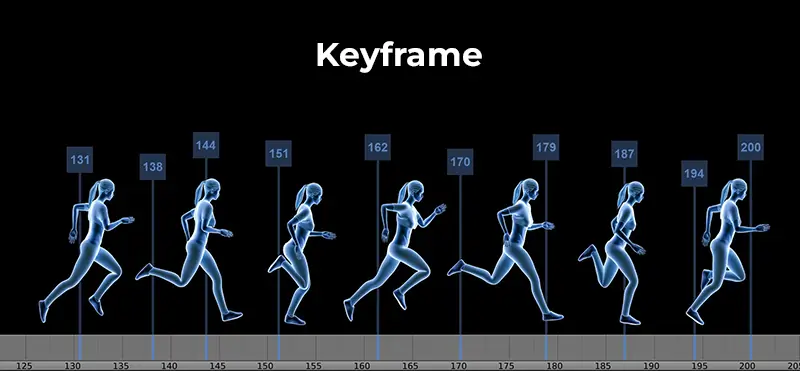
Keyframes are points that mark the start and end of an action in the digital animation. Each action will have its own keyframe.
-
Timeline
A timeline is a visual representation of all the frames, keyframes, and motion paths in an animation.
Others
-
360 spin/360 image
A 360 spin (also called a 360º image or 360 rotation) is a type of product photography that shows a 360-degree view of a product. Viewers can “spin” the image around with a mouse or a finger on the screen. 360-degree views are made in two ways:
- By taking numerous photos of a product from different angles and then digitally stitching them together to create a 360º image.
- By generating a 360º view of a product from a 3D file or other information using a software.
-
3D commerce
3D commerce is basically the practice of using 3D models to augment or boost online shopping experiences. It allows online shoppers to view products from multiple angles (like with 360-degree views), zoom in, rotate, and interact with the models. The idea of 3D commerce is to make online shopping a more realistic and, therefore, immersive experience for people who shop online.
3D commerce employs the use of:
- Interactive 3D or 360º images
- Augmented reality applications
- Virtual reality applications
-
CGI photography
CGI photography is where 3D models are used to create photorealistic images and videos. You’ll find that this is mostly used for the visualization and advertising of products. CGI photography is very similar to real life photography, but here you’re “taking pictures” of a 3D model instead of the actual product.
-
3D configurator
A 3D configurator is a tool with which users can customize a product by interacting with its 3D model. They can change product features like color, materials, and size, and watch the changes in real time. It essentially allows you to personalize the product before purchase. You’ll find that 3D configurators are usually used in the automotive and furniture industries, where customization is common. For example, on eCommerce sites like Amazon.
-
Augmented reality
Augmented reality (AR) is a semi-immersive technology. It is only semi-immersive because people can interact with digital content while also being present in and interacting with the real world. Digital content (text, images, etc.) is overlaid on the real world through devices like smartphones, tablets, smart glasses, and headsets.
-
Virtual reality
Virtual reality is a fully immersive experience where a person interacts with a super realistic computer-generated environment. Unlike augmented reality, the user is disconnected from the real world and immersed into a virtual world, where they interact with digital elements using special hardware (like a VR headset) and software.
We’ve come to the end…
If you ever feel like you need to brush up on the meanings of the terms used in different 3D processes, you can always come back here beginner’s guide to 3D terminology. Just in case, bookmark this page so you can find it in no time.
Get in touch!
